Diving with Cuttlefish
Lanta Marine Life | Sepiidae
Cuttlefish are not a fish but mollusc of the class Cephalopoda. There are over 100 species found worldwide, with some species regularly seen during Koh Lanta diving.
They have large oval bodies with a frilled fin along the sides and gain speed by squirting water from a tube beneath the head, a type of jet propulsion. When alarmed, they eject a sepia ink to cloud the water and confuse their predators.
All cuttlefish have an unique internal porous structure called the cuttlebone and each species has a different texture, shape and size. They are able to adjust their buoyancy, by altering the amount gas and liquid in their cuttlebone.
Their blood is an unusual shade of blue-green due to a copper protein carrying oxygen instead of the red iron protein. Their blood is pumped by 3 separate hearts. One for each gill and a third pumps blood around their their body.
Cuttlefish have 8 arms lined with suckers surrounding their toxic beaked mouth, but unlike Octopus and Squid they also have 2 tentacles capable of grabbing. Cuttlefish like to dine on small crustacea and are known to occasionally indulge in a little cannibalism.
Cuttlefish are colour blind yet their camouflage is one of the best. It's the Chromatophores in their skin that gives them the amazing ability to match the colour and texture of the substrate, even in total darkness. Their eyes are fully developed before hatching, allowing them to observe their surroundings while still encased in their egg.
During mating season a female may mate with several males, storing the sperm and later deciding which one will fertilise her 200 or so large grape like eggs. The young are miniatures of their parents and will begin hunting immediately.
2 species found on this page:
Pharaoh Cuttlefish
(Sepia pharaonis)

Sepia pharaonis @ Hin Bida
The Pharaoh Cuttlefish's body is covered in a mantle which (when not attempting camouflage) is a tan-brown colour, covered with many wavy white lines running from one side, across the back, to the other side. The head is mottled tannish-browning with whitish markings.
The mantle has a mostly white margin, with small brownish bars which create short sections of white spots.
The underside of the fins is white. The underside of the body is a pale to light tan - whitish - pinkish pattern and can change as part of the camouflage routine.
The head is mottled brown, with the arms showing white spots and blotches on the leading edges, and more mottled pattern on the lagging edges.The underside of the arms is white.
As with other cuttlefish, this species can rapidly change the body, head and tentacle colours and patterns which can make identification more difficult.
The adult Pharaoh Cuttlefish are one of the larger cuttlefish species, growing to 43 cm, but usually observed smaller than this, ranging from juveniles a few cm in length, up to around 25 cm for larger individuals. The diet includes small crustaceans, small fish, and other juvenile cuttlefish.
Shortly after spawning, the male Pharaoh Cuttlefish will die, and then, shortly after brooding of the young has finished, the female Pharaoh Cuttlefish will also die.
Needle Cuttlefish
(Sepia aculeata)

Sepia aculeata @ Koh Haa
The Needle Cuttlefish is usually found in shallow areas on sandy bottoms and rubble areas close to coral reefs, occasionally in deeper water.
We are most likely to find this cephalopod around the Koh Haa Lagoon area, or the shallower areas around the Bida Islands, Koh Rok and Koh Phi Phi.
This species has an oblong mantle, with the dorsal usually covered with white blotches, spots or patches. The head and arms have scattered small tubercles (small rounded projections).
Generally the Needle Cuttlefish has a pale brown color, but is capable of rapid color change to match surroundings.
The Needle Cuttlefish usually feed on crustaceans and small fish, growing up to 23 cm in some areas, however specimens caught in the Andaman Sea have mantles varying from 6 cm - 13 cm.
This is an important commercial species, with most animals becoming fully mature in the early months of the year.
Diving with Cuttlefish around Koh Lanta
Scuba Diving & Snorkel Trips
If you'd love a chance to spot Cuttlefish on one of our daily high season diving trips from Koh Lanta then send us an email to info@diveandrelax.com.
Join our high season speedboat dive trips to some of Thailand's best dive sites and enjoy small groups, short journey times, with a focus on great personal service, safety and fun.
Not yet a certified diver? Learn to Scuba Dive on Koh Lanta with the 3 day SSI Open Water Diver course.
Book online to save 10% on dive trips and scuba courses on Koh Lanta.
Find Out More
Indo-Pacific Marine Life Guides
- Allen, G., Steene, R., Humann, P., DeLoach, N. (2003) Reef Fish Identification, Tropical Pacific. Jacksonville, FL., USA: New World Publications, Inc., ISBN 1-878348-36-1.
- Humann, P., DeLoach, N., (2010) Reef Creature Identification, Tropical Pacific. Jacksonville, FL., USA: New World Publications Inc., ISBN 978-1-878348-44-9
- Debelius, H. (2013) Indian Ocean Reef Guide. Frankfurt, Germany: IKAN - Unterwasserarchiv, ISBN 978-3-939767-52-7.
- Debelius, H. (2004) Nudibranchs and Sea Snails, Indo-Pacific Field Guide. Frankfurt, Germany: IKAN - Unterwasserarchiv, ISBN 3-925919-51-1
- Erhardt, H., Knop, D. (2015) Corals Indo-Pacific Field Guide. Frankfurt, Germany: IKAN - Unterwasserarchiv, ISBN 3-925919-69-4.
- Veron J.E.N., Stafford-Smith M.G., Turak E. and DeVantier L.M. (2016). Corals of the World
